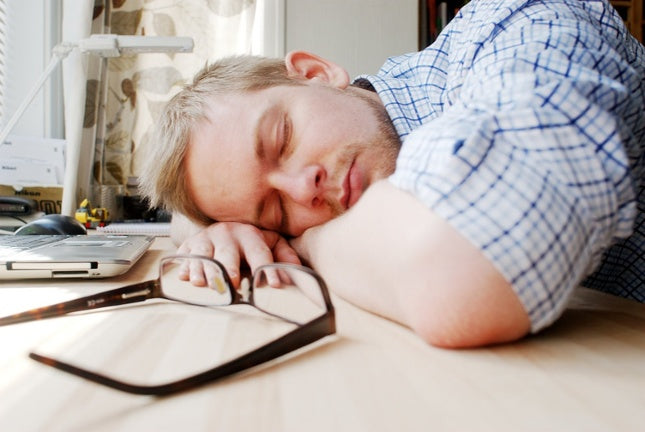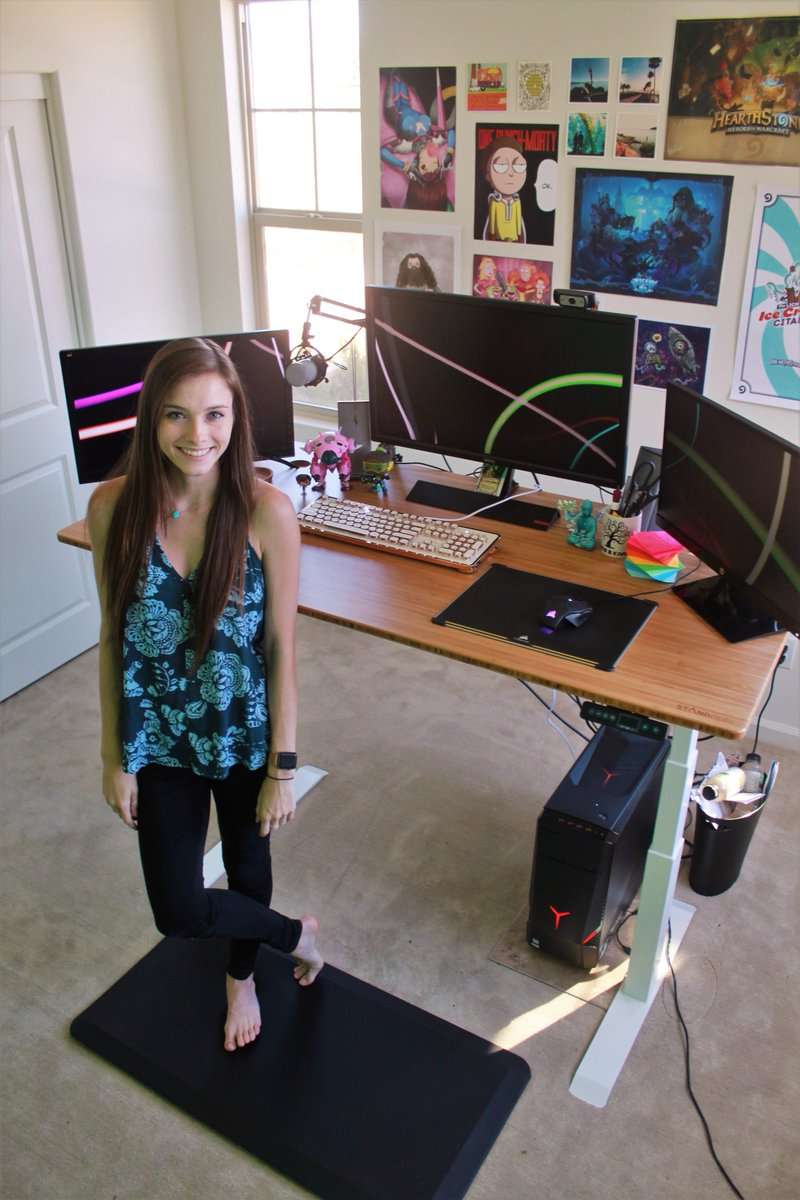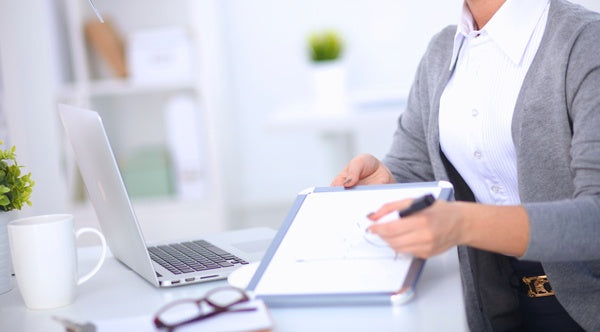5 Tips for Combatting Mid-Day Sleepiness
Sleep is a hard thing to come by sometimes, when life gets in the way. But on nights when you are able to jump into bed at a reasonable hour, you wake up prepared to take on the workday.
Shop All Standing Desks
Early to bed, early to rise right? You come in wide awake and ready, and generally the first few hours of your day aren’t lacking in the energy department. A couple of hours pass and you’ve had your lunch break, but soon after your energy suddenly drops, and you begin dozing off behind your computer screen as your eyelids become heavier. You start to wonder why you’re getting sleepy despite having gotten an adequate amount of sleep. Sound familiar?

We humans are evolutionarily programmed, so to speak, to fall into a slumber in the middle of the day. Our circadian rhythm is one of two driving forces behind this which is controlled by the area in our brain that responds to light. This is the reason why we sleep when it’s dark and vice versa. The other driving force that regulates sleep is sleep/wake homeostasis. This body system creates a pattern for sleep based on how long we’ve been awake since our last adequate sleeping cycle. Basically, the longer we’ve been awake, the stronger the desire to go to sleep.
But we’ve yet to answer the million dollar question - why do we feel sleepy in the middle of the day? The answer brings us back to the circadian rhythm, which also causes our levels of wakefulness to ebb and flow throughout the day. When we experience mid-day dips, we don’t necessarily need sleep, our body just misleads us to feeling like we do.
Regardless, we still experience this midday drowsiness, and it interferes with our work and productivity. There are many solutions available, so we’ve compiled some of our favorites that you can compound to maximize your awoken state.
Here are five ways to keep yourself awake during the day.
#1. Expose Yourself to More Natural Light

Chances are that there aren’t a lot of windows by your work station in the office. Even though the room you’re in may be well lit, it doesn’t have natural sunlight coming in from the outside. If you consider the amount of time you spend inside, let alone in front of your computer screen, you are lacking any real vitamin D for the vast majority of your day. Kind of depressing, right?. For many of us, confined to smaller office spaces, this is doubly so - so it’s natural that we should occasionally feel the desire to take it outside and stretch our legs.
Shop All Standing Desks
Once a day, after-lunch or whenever you start to feel drowsy, take that step out the door for a while and experience the world outside the office. The sun is energizing for plant life and your own!
Surrounding yourself in nature and feeling the cool breeze on your skin goes a long way in increasing your vitality and alertness. One particular study, published in the June 2010 issue of the Journal of Environmental Psychology, showed that people on wilderness excursions recall feeling more alive and happier. Light inhibits the pineal gland’s production of melatonin, the hormone that assists your sleepiness. This also contributes to why we sleep at night. Natural sunlight works best since it forces you to be outside and you allow your body to absorb vitamin D, a vital substance for fueling bodily processes.
#2. Stand Up!

Whether you’re outside taking in what’s around you or still inside the office, simply standing up will keep you more alert. The act of switching from sitting to standing will get your blood flowing, which supplies your brain with more oxygen, thus giving you more energy.
If your profession requires you to always be at your desk, consider using an adjustable height desk. The benefits cannot be overstated when it comes to using a standing desk, and include alleviation of back pain, weight loss, lower chance of heart disease and diabetes, reduced stress and higher energy levels. One study published in the AAP News & Journals investigated the impact of standing desks in schools, and discovered improvements in aspects such as behavior, physical activity, and productivity in children.
You can go even further by taking a 10 minute break to take a brisk walk. A study conducted by Robert Thayer, PhD, a professor at California State University, discovered that a 10 minute walk produced more sustained energy in its subjects than eating a candy bar. The participants who ate the candy bar actually found themselves more tired after about an hour, whereas those who took a walk had more energy for up to two hours.
#3. Eat a Healthy Snack

There are many healthier alternatives to candy bars that can still satisfy your sweet tooth and give you energy. Coffee is reliable in keeping you awake, but you experience crashes and heightened heart rates. While it’s known that food sustains you while you’re awake, not enough people are aware of snacks that don’t cause you to put on additional weight, or make you feel heavier after consumption. Here are a few midday snacks to try:
*Green tea and dark chocolate are less caffeinated substitutes for coffee that still get the job done without inducing a crash a couple of hours later.
*Whole grains and protein both offer slow burning energy that sustains you for the day. Refined sugars, like white bread and white rice, break down much more quickly so you don’t get enough fuel. Some examples of whole grain snacks include wheat crackers and no-butter popcorn. Beef jerky is a great protein to eat because it forces you to chew thoroughly, which also keeps you awake by releasing insulin.
#4. Listen to Music

Sometimes our backend work becomes tedious and repetitive. Some days, there’s not much variety to what we’re doing, and staring at the computer doing the same thing for awhile can lull us to sleep at times. When that happens for me, I like to put on a set of earbuds and listen to music. There are studies that have discovered that listening to music increases productivity, especially in the face of repetition. As we become more effective at our tasks, we enter a zone in which we begin hitting a stride and almost feel unstoppable. Music engages us in ways not easily mimicked and provides a stimulus for our brain that stands out.
Pick your favorite tune, or choose something more ambient if you’re worried about getting distracted. Services like Focus@Will offer playlists specifically designed to foster productivity based on brain activity, making sure each song is different enough from the previous one that it doesn’t feel repetitive, but similar enough that the transition isn’t jarring or distracting.
#5. Take a Short Nap (but only if you must!)

Despite being in well-lit rooms, taking frequent walks, and eating enough to sustain you for the day, dozing off may still be an inevitability for some people. After all, our circadian rhythm dictates when we sleep, and perhaps your room gets a bit stuffy and the warmth embraces you. The good news is that it only takes 10-20 minutes of shuteye to feel rested.
During this initial period of sleep, you enter the sleep cycle only as far as non-rapid eye movement (non-REM). This means that once you wake up from your short slumber, you won’t feel the grogginess that comes as a result of sleep inertia. Just make sure your nap doesn’t last longer than 30 minutes, at which point you enter deep sleep, or you run the risk of waking up more tired.
Sleeping at your workstation may be a bit dicey depending on your office’s work culture, so you may want to step away from your desk and to a quieter spot.
Shop All Standing Desks







